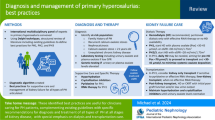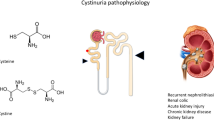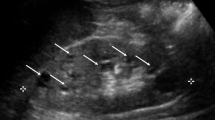Abstract
Purpose
The aim of our study is to describe the genetic features and correlation between the genotype and phenotype of Chinese patients with primary hyperoxaluria type 3 (PH3).
Methods
The genetic and clinical data of PH3 patients in our cohort were collected and analyzed retrospectively. All published studies of Chinese PH3 populations between January 2010 and November 2022 were searched and enrolled based on inclusive standards.
Results
A total of 60 Chinese PH3 patients (21 cases from our cohort and 39 cases from previous studies) were included. The mean age of onset was 1.62 ± 1.35 (range 0.4–7) years. A total of 29 different variants in the HOGA1 gene were found. The mutations were most commonly clustered in exons 1, 6, and 7. Among the genotypes, exon 6 skipping (c.834G > A and c.834_834 + 1GG > TT mutations) was the most common, followed by c.769 T > G; the allele frequencies (AFs) were 48.76% and 12.40%, respectively. Patients homozygous for exon 6 skipping exhibited a median age of onset of 0.67 (0.58–1) years, which was significantly lower than that observed among heterozygotes and nonexon 6 skipping patients (p = 0.021). A total of 22.5% (9/40) of PH3 patients had a decreased estimated glomerular filtration rate, and one patient with homozygous exon 6 skipping developed end-stage renal disease.
Conclusions
A hotspot mutation, potential hotspot mutation and genotype–phenotype correlation were found in Chinese PH3 patients. This study expands the mutational spectrum and contributes to the understanding of genotypic profiles of PH3, which may provide a potential diagnostic and therapeutic target.


Similar content being viewed by others
Data availability
The data that support the findings of this study are available from the corresponding author upon reasonable request.
References
Williams EL, Bockenhauer D, van’t Hoff WG et al (2012) The enzyme 4-hydroxy-2-oxoglutarate aldolase is deficient in primary hyperoxaluria type 3. Nephrol Dial Transpl 27(8):3191–3195. https://doi.org/10.1093/ndt/gfs039
Belostotsky R, Pitt JJ, Frishberg Y (2012) Primary hyperoxaluria type III–a model for studying perturbations in glyoxylate metabolism. J Mol Med (Berlin) 90(12):1497–1504. https://doi.org/10.1007/s00109-012-0930-z
Monico CG, Rossetti S, Belostotsky R et al (2011) Primary hyperoxaluria type III gene HOGA1 (formerly DHDPSL) as a possible risk factor for idiopathic calcium oxalate urolithiasis. Clin J Am Soc Nephrol 6(9):2289–2295. https://doi.org/10.2215/cjn.02760311
Hoppe B (2012) An update on primary hyperoxaluria. Nat Rev Nephrol 8(8):467–475. https://doi.org/10.1038/nrneph.2012.113
Cochat P, Rumsby G (2013) Primary hyperoxaluria. N Engl J Med 369(7):649–658. https://doi.org/10.1056/NEJMra1301564
Allard L, Cochat P, Leclerc AL et al (2015) Renal function can be impaired in children with primary hyperoxaluria type 3. Pediatr Nephrol (Berlin, Germany) 30(10):1807–1813. https://doi.org/10.1007/s00467-015-3090-x
Richard E, Blouin JM, Harambat J et al (2017) Late diagnosis of primary hyperoxaluria type III. Ann Clin Biochem 54(3):406–411. https://doi.org/10.1177/0004563216677101
Riedel TJ, Johnson LC, Knight J et al (2011) Structural and biochemical studies of human 4-hydroxy-2-oxoglutarate aldolase: implications for hydroxyproline metabolism in primary hyperoxaluria. PLoS ONE 6(10):e26021. https://doi.org/10.1371/journal.pone.0026021
Hopp K, Cogal AG, Bergstralh EJ et al (2015) Phenotype-genotype correlations and estimated carrier frequencies of primary hyperoxaluria. J Am Soc Nephrol 26(10):2559–2570. https://doi.org/10.1681/asn.2014070698
Abid A (2021) Possible ethnic associations in primary hyperoxaluria type-III-associated HOGA1 sequence variants. Mol Biol Rep 48(4):3841–3844. https://doi.org/10.1007/s11033-021-06380-3
Wang W, Liu Y, Kang L et al (2019) Mutation hot spot region in the HOGA1 gene associated with primary hyperoxaluria type 3 in the Chinese population. Kidney Blood Press Res 44(4):743–753. https://doi.org/10.1159/000501458
Khamis MM, Adamko DJ, El-Aneed A (2017) Mass spectrometric based approaches in urine metabolomics and biomarker discovery. Mass Spectrom Rev 36(2):115–134. https://doi.org/10.1002/mas.21455
Wang X, Zhao X, Wang X et al (2015) Two novel HOGA1 splicing mutations identified in a Chinese patient with primary hyperoxaluria type 3. Am J Nephrol 42(1):78–84. https://doi.org/10.1159/000439232
Zhou LQ, Wang Q, Zhang LM et al (2016) Primary hyperoxaluria type III in one patient and literature review. J Mod Urol. https://doi.org/10.3969/j.issn.1009-8291.2016.04.010
He L, Xu G, Fang X et al (2019) Identification of 8 novel gene variants in primary hyperoxaluria in 21 Chinese children with urinary stones. World J Urol 37(8):1713–1721. https://doi.org/10.1007/s00345-018-2563-5
Fang X, He L, Xu G et al (2019) Nine novel HOGA1 gene mutations identified in primary hyperoxaluria type 3 and distinct clinical and biochemical characteristics in Chinese children. Pediatr Nephrol (Berlin, Germany) 34(10):1785–1790. https://doi.org/10.1007/s00467-019-04279-7
Zhang XYG (2020) Primary hyperoxaluria type 3: a case report. Chin J Nephrol. https://doi.org/10.3760/cma.j.cn441217-20200113-00088
Zhao Y, Li Y, Fang X et al (2022) Extended genetic analysis of exome sequencing for primary hyperoxaluria in pediatric urolithiasis patients with hyperoxaluria. Gene 815:1455. https://doi.org/10.1016/j.gene.2021.146155
Zhao Y, Fang X, He L et al (2022) A comparison of the clinical characteristics of pediatric urolithiasis patients with positive and negative molecular diagnoses. World J Urol 40(5):1211–1216. https://doi.org/10.1007/s00345-022-03934-3
Ji X, Liu J, Wang C et al (2022) Primary hyperoxaluria type 3 in 8 children: a case series report and literature review. Chin J Evid-Based Pediatr 17(3):003. https://doi.org/10.3969/j.issn.1673-5501.2022.03.011
Abid A, Raza A, Aziz T et al (2022) HOGA1 gene pathogenic variants in primary hyperoxaluria type III: spectrum of pathogenic sequence variants, and phenotypic association. Hum Mutat. https://doi.org/10.1002/humu.24490
Capalbo A, Valero RA, Jimenez-Almazan J et al (2019) Optimizing clinical exome design and parallel gene-testing for recessive genetic conditions in preconception carrier screening: translational research genomic data from 14,125 exomes. PLoS Genet 15(10):e1008409. https://doi.org/10.1371/journal.pgen.1008409
Kars ME, Başak AN, Onat OE et al (2021) The genetic structure of the Turkish population reveals high levels of variation and admixture. Proc Natl Acad Sci USA. https://doi.org/10.1073/pnas.2026076118
Riedel TJ, Knight J, Murray MS et al (2012) 4-Hydroxy-2-oxoglutarate aldolase inactivity in primary hyperoxaluria type 3 and glyoxylate reductase inhibition. Biochem Biophys Acta 1822(10):1544–1552. https://doi.org/10.1016/j.bbadis.2012.06.014
Belostotsky R, Seboun E, Idelson GH et al (2010) Mutations in DHDPSL are responsible for primary hyperoxaluria type III. Am J Hum Genet 87(3):392–399. https://doi.org/10.1016/j.ajhg.2010.07.023
Williams EL, Bagg EA, Mueller M et al (2015) Performance evaluation of Sanger sequencing for the diagnosis of primary hyperoxaluria and comparison with targeted next generation sequencing. Mol Genet Genomic Med 3(1):69–78. https://doi.org/10.1002/mgg3.118
Pitt JJ, Willis F, Tzanakos N et al (2015) 4-hydroxyglutamate is a biomarker for primary hyperoxaluria type 3. JIMD Rep 15:1–6. https://doi.org/10.1007/8904_2013_291
Beck BB, Baasner A, Buescher A et al (2013) Novel findings in patients with primary hyperoxaluria type III and implications for advanced molecular testing strategies. Eur J Hum Genet 21(2):162–172. https://doi.org/10.1038/ejhg.2012.139
M’Dimegh S, Aquaviva-Bourdain C, Omezzine A et al (2017) HOGA1 gene mutations of primary hyperoxaluria type 3 in Tunisian patients. J Clin Lab Anal. https://doi.org/10.1002/jcla.22053
Pelle A, Cuccurullo A, Mancini C et al (2017) Updated genetic testing of Italian patients referred with a clinical diagnosis of primary hyperoxaluria. J Nephrol 30(2):219–225. https://doi.org/10.1007/s40620-016-0287-4
Richards S, Aziz N, Bale S et al (2015) Standards and guidelines for the interpretation of sequence variants: a joint consensus recommendation of the American College of Medical Genetics and Genomics and the Association for Molecular Pathology. Genet Med 17(5):405–424. https://doi.org/10.1038/gim.2015.30
Maleki Dizaj S, Eftekhari A, Mammadova S et al (2021) Nanomaterials for chronic kidney disease detection. Appl Sci 11(20):9656. https://doi.org/10.3390/app11209656
Hoppe B, Koch A, Cochat P et al (2022) Safety, pharmacodynamics, and exposure-response modeling results from a first-in-human phase 1 study of nedosiran (PHYOX1) in primary hyperoxaluria. Kidney Int 101(3):626–634. https://doi.org/10.1016/j.kint.2021.08.015
Eftekhari A, Vahed SZ, Kavetskyy T et al (2020) Cell junction proteins: crossing the glomerular filtration barrier in diabetic nephropathy. Int J Biol Macromol 148:475–482. https://doi.org/10.1016/j.ijbiomac.2020.01.168
Acknowledgements
We are very grateful to the Beijing Municipal Administration of Hospitals Clinical Medicine Development of Special Funding (XMLX202101) for its support of this work.
Author information
Authors and Affiliations
Contributions
All authors contributed to the study conception and design. Study design and data collection: Yucheng Ge, Yukun Liu and Wenying Wang. Data statistical analysis/interpretation: Yucheng Ge and Jun Li. Yucheng Ge and Yukun Liu wrote the manuscript. Wenying Wang and Ye Tian revised the manuscript. Ruichao Zhan and Zhenqiang Zhao prepared Figs. 1, 2 and Table 1. All authors reviewed the manuscript. All authors contributed to the revision and drafting of the article.
Corresponding authors
Ethics declarations
Conflict of interest
The authors declare that they have no conflicts of interest.
Ethical approval
This study was performed in line with the principles of the Declaration of Helsinki. Approval was granted by the Ethics Committee of Beijing Friendship Hospital, Capital Medical University (Date 02/01/2021/No. 2021-P2-019).
Consent to participate
Informed consent was obtained from the parents or guardians of the patients included in the study.
Additional information
Publisher's Note
Springer Nature remains neutral with regard to jurisdictional claims in published maps and institutional affiliations.
Supplementary Information
Below is the link to the electronic supplementary material.
Rights and permissions
Springer Nature or its licensor (e.g. a society or other partner) holds exclusive rights to this article under a publishing agreement with the author(s) or other rightsholder(s); author self-archiving of the accepted manuscript version of this article is solely governed by the terms of such publishing agreement and applicable law.
About this article
Cite this article
Ge, Y., Liu, Y., Zhan, R. et al. HOGA1 variants in Chinese patients with primary hyperoxaluria type 3: genetic features and genotype–phenotype relationships. World J Urol 41, 2141–2148 (2023). https://doi.org/10.1007/s00345-023-04461-5
Received:
Accepted:
Published:
Issue Date:
DOI: https://doi.org/10.1007/s00345-023-04461-5




